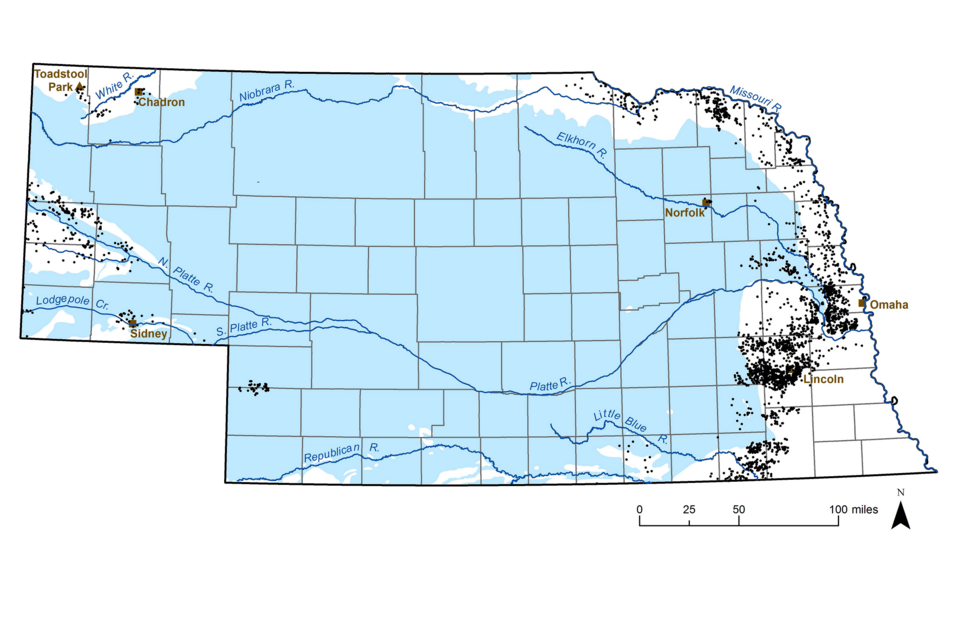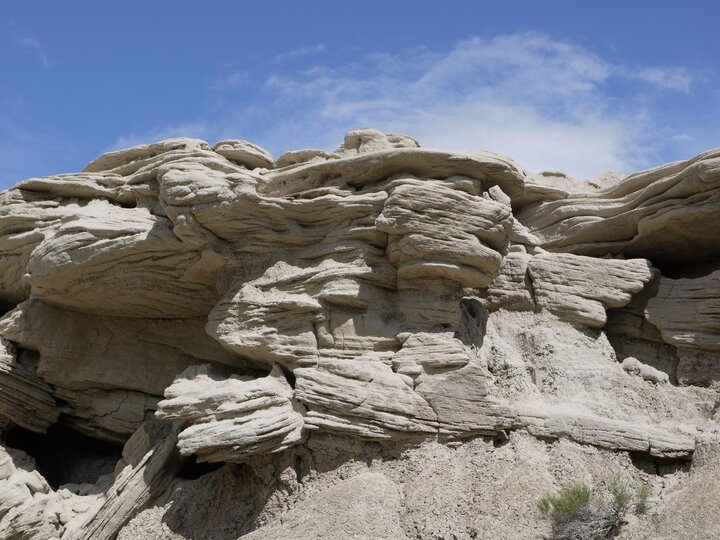An Overview of Secondary Aquifers in Nebraska

Nebraska is a groundwater-rich state, thanks in part to the High Plains Aquifer. Many people are familiar with the High Plains Aquifer (also sometimes called the Ogallala aquifer), but fewer people know that there are other aquifers in the state. In fact, Nebraska has seven secondary aquifers, which are much smaller in areal extent than the High Plains Aquifer and generally have poorer water quality, but are nonetheless important in places where the High Plains Aquifer and shallow sand gravel deposits are absent. In the accompanying map, the extent of the High Plains Aquifer in Nebraska is shown in blue; black dots represent wells completed in secondary aquifers. These secondary aquifers are the sole water supply for more than 4,000 active wells spread across 30 counties in eastern and western Nebraska.
The Dakota aquifer (formally called the Maha Aquifer) is by far the largest of these secondary aquifers, supplying all of the water to more than 3,400 wells in eastern Nebraska. Seventy-five percent of these wells are domestic, although in places the aquifer is capable of supplying a sufficient volume of water for irrigation and commercial use. The biggest limitation to using the Dakota aquifer is potentially high salt concentrations. Geologists think the salty water probably moves into the Dakota aquifer from underlying rocks, a hydraulic condition that is increased by heavy pumping.
Other secondary aquifers in eastern Nebraska include the Niobrara aquifer (230 wells, mostly in Cedar County), the Codell aquifer (70 wells in Knox and Boyd counties), and the Western Interior Plains Aquifer System. Only one active well is currently installed in the Western Interior Plains Aquifer System in Nebraska, but the aquifer system was a historic source of water to the Omaha area, and still supplies huge volumes of water to Iowa and other states to our east.
The Chadron aquifer is the sole source of water to more than 160 wells in the Nebraska panhandle and supplies some of the water to at least 50 additional wells, most of which are near the Perkins-Chase county line. Chadron wells average about 350 feet deep, and the majority (64%) are used for domestic supply, but livestock and irrigation wells account for 15% and 12% of the wells, respectively. The biggest challenge to using the Chadron aquifer is poor water quality. Total dissolved solids and sodium concentrations are uniformly high, but other aspects of water chemistry vary from place to place. Arsenic and uranium concentrations have both been documented to exceed their recommended maximum contaminant levels in places, and Chadron well owners should consider testing their wells for these compounds.

Figure1. Brule sandstone at Toadstool Geologic Park, Sioux County, Nebraska
The Brule sand-sandstone aquifer and the Upper Cretaceous aquifer are the other two secondary aquifers in western Nebraska. The Brule sand-sandstone aquifer is distinguished from wells installed in Brule siltstone. The sand and sandstone units in the Brule Formation were deposited in ancient stream valleys and generally have higher porosity than the Brule siltstone that is common elsewhere in western Nebraska. More than 140 wells currently source all of their water from Brule sand-sandstone units and generally have good water quality. The Upper Cretaceous aquifer supplies water to only about 13 wells, mostly in western Scotts Bluff County, although it is heavily used in the Denver area. The Upper Cretaceous aquifer has high sodium, and sometimes high chloride concentrations in Nebraska.
To learn more about the secondary aquifers of Nebraska, download the Conservation and Survey Division publication titled ‘An Overview of Secondary Aquifers in Nebraska’ available at http://digitalcommons.unl.edu/conservationsurvey/138. Questions regarding western Nebraska aquifers may be directed to Steve Sibray at 308-632-1382; questions regarding eastern Nebraska aquifers may be directed to Dana Divine at 402-472-3288.
This article was reviewed by Steve Sibray & R.F. Diffendal, Jr.